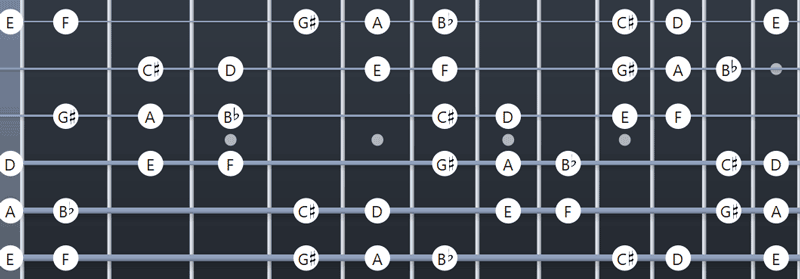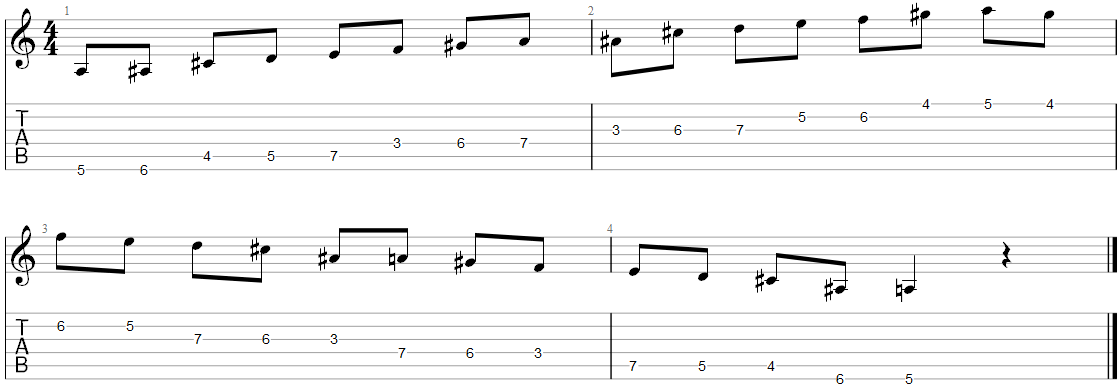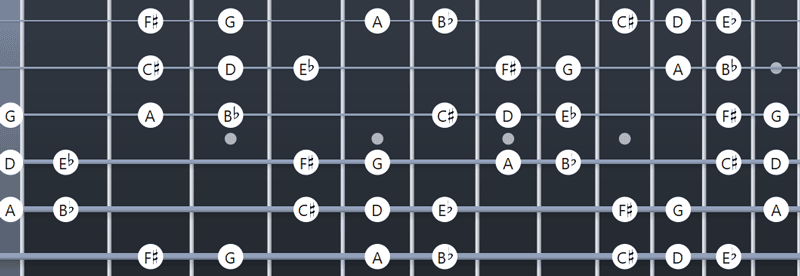Episode 16 of the Bite-Size Guitar Podcast looks at three more ways you can use a looper pedal as a practicing tool.
I covered the first three ways in Episode 8. Those three ways give you a solid way to practice with a looper pedal. The three ways in this episode take a slightly different approach and give you something to try out.
Listen to the podcast using the below player or search for Bite-Size Guitar Podcast in any podcast app.
Ask a Question
If you have a question about this episode or any other question about learning or playing guitar, ask it here and I’ll answer it in a future episode.
Use your Android/PC/Mac (iOS doesn’t work) to record your question below and send it to me to be included in a future episode.
Tips for asking a question for the podcast:
- Introduce yourself at the start (eg: Hi, I’m Aaron from Australia …)
- Try to record in a quiet environment to avoid background noise
- You have up to 90 seconds to record, so take your time providing any details you want
If you want to send me a question in text instead of voice, you can send it here.
Useful Resources
Here are some handy resources related to this episode:
- Episode 8: Using a Looper Pedal as a Practice Tool
- Best Looper Pedals
- How to Use a Looper Pedal
- WireTap Riff Recorder Review (what I use to record any song ideas)
Exotic Scales to Practice
As explained in the episode, a looper pedal is a great way to memorize scales (as well as anything else on guitar).
To see what I mean when I say this, try recording these scale runs on your looper pedal, then try to play them in sync with your recording without looking at the Guitar TAB or scale diagrams.
If you do this, you’ll understand how a looper pedal can be used to speed up the memorization process.
A Byzantine Scale
The Byzantine scale is a great introduction to exotic scales and if you’ve never played something like this before, the large gaps between some notes will feel extreme.

Here’s an example of a scale run you can record with your looper pedal to practice over:

Remember that the goal is to try and memorize this scale, so try to avoid looking at the above TAB or diagram and use your ears to figure out if you played the right notes or not.
A Oriental Scale
While the Byzantine scale has a lot of wide interval jumps, the Oriental scale combines some wide jumps with a lot of chromatic notes.

Try recording the below scale run, then once you memorize it, try coming up with a scale run in a different position using the above fretboard diagram.
 While I don’t typically recommend learning scales using scale runs like this, these simple exercises give you a clear idea how useful a looper pedal can be to help you memorize something.
While I don’t typically recommend learning scales using scale runs like this, these simple exercises give you a clear idea how useful a looper pedal can be to help you memorize something.
If you do want to learn scales, read this guide on how to practice guitar scales.
Podcast Episode 16 Transcript
Hi, I’m Aaron from guitargearfinder.com and this is episode 16 of the Bite-Size Guitar podcast.
In the last episode, I covered three ways you can use a metronome to improve your guitar skills. I had a lot of positive feedback from listeners about that episode, so in this episode, let’s have a look at a different tool you can use for practice.
In episode 8, I covered a few ways you can use a looper pedal as a practice tool. I explained how you can use it to practice parts you’re learning, work on your rhythm skills, and as a way to apply music theory to your playing. But there’s a lot of other ways you can make use of a looper pedal as a practice tool.
In this episode, I’ll go through three ways you can use a looper pedal to work on different aspects of your playing.
Memorization
The first way is to help you memorize things on guitar. Whether you’re learning a scale, chord shapes, licks, or a full song, you can use a looper pedal to reinforce anything you’re trying to memorize.
The reason the looper pedal is a great tool to help you memorize something is that memorization is all about repetition.
If you repeat something over and over enough times, it eventually sinks in.
You’ve probably heard of muscle memory, and while that term is a bit misleading – maybe I’ll cover it in a future episode if people are interested – it gives you a rough idea of what it takes to memorize something.
The basic idea behind using a looper pedal to help you memorize something is that it gives you a structured way to repeat the thing you want to memorize.
You record yourself playing the thing you want to memorize, or if your looper pedal has the feature, you can load an audio clip onto it of what you want to memorize.
You then have an easy way to practice the thing you want to memorize locked into a specific tempo. Playing along with the loop is an easy way to hear if your rhythm is in sync if you’re hitting the right notes or any other issues with your playing.
To get an idea of what I’m talking about, here’s something you can try.
Lookup a scale you’ve never played before. I’ve included a couple of exotic scales on the page for this episode with Guitar TAB, so check it out for some great sounding scales.
Now record yourself playing up and down that scale using your looper pedal.
After you finish recording and the looper starts playing the scale back, practice playing over the top of it without looking at the scale diagram or Guitar TAB.
If you can play it ten times in a row without any mistakes, take a five-minute break, then come back and play it again. See if you can play it ten times in a row without looking up the scale. If you can, take another break and repeat this over and over.
This is called spaced repetition and following this method speeds up how long it takes to properly memorize something.
The key point is that the looper pedal gives you a quick and easy way to jump straight back into practicing that scale. If your looper pedal allows you to save multiple loops in different storage slots, that’s even better. You can easily build up a library of licks, scales, or parts you want to memorize.
The basic idea behind using the looper pedal this way is simple. It just gives you a structured way to play along with something instead of just playing it on your own. It might not seem like much of a difference, but it makes a huge difference to how long it takes to properly memorize something.
Give it a try and you’ll see what I mean.
Songwriting
The next way you can use a looper pedal is to use it to help you work on song ideas. If you’re a songwriter or you want to start getting into writing your own music, a looper pedal can be a handy tool to have.
Let’s say you’re jamming and you suddenly come up with a great sounding riff. When inspiration strikes, it’s important to quickly capture your ideas. If this has happened to you before, you’ll know that once you come up with an idea, it doesn’t take long before the idea starts to change as you play it. You might jam on it for a bit, then realize that you’ve changed it so much that you don’t remember what the initial idea was that inspired you.
With a looper pedal, you can instantly hit the footswitch and record your idea before it starts to morph or fade from your memory. I can’t tell you how many times I’ve lost great song ideas because I didn’t immediately capture them.
Simply record your idea, then you can play around with it knowing that it’s not going to disappear from your memory.
Then, you can use the looper pedal to help give structure to your song ideas. You can start jamming over the top of your new idea and come up with other parts that fit together.
Let’s say you come up with a great sounding lick. Well, now with that lick safely stored in your looper pedal’s memory, you can look for ways to work that lick into a song. You can try to come up with a chord progression that fits underneath that melody. Or come up with different harmonies to work with it.
The key point to remember is that you can use a looper pedal as a songwriting tool to help give you structure. You can sit back and listen to your new ideas with fresh ears, then try to work in different guitar parts with that idea.
Once I started using a looper pedal in this way, my songwriting rapidly improved.
Now I use a slightly different pedal when coming up with song ideas. I use a WireTap Riff Recorder by TC Electronic, which is a pedal designed to quickly record any ideas you have. But you can do pretty much the same thing with a looper pedal. If you don’t yet have a looper pedal and you’re interested in writing your own music, I recommend getting one that allows you to save multiple recordings you can then upload to a computer via USB or SD Card. Check out my guide on looper pedals to learn more about these options.
Ear Training
The last way I suggest trying to use your looper pedal is to develop your critical ear.
I’ve mentioned quite a few times in earlier episodes the importance of ear training. If you haven’t been keen on the idea of ear training exercises, using a looper pedal might be a better option for you.
There are a lot of ways you can use a looper to work on your ear skills.
If your looper pedal lets you store multiple loops, here’s a good way to start working on your ear skills.
Record yourself playing a random chord progression, then store it to your pedal. Record a different chord progression and save it to another slot and keep recording different progressions using a variety of open and barre chords.
Then leave those recordings on your pedal for at least a day. The next day when you go to practice, hit play on one of those random chord progressions and figure out by ear what chords you played.
Some chords you’ll immediately recognize, while others may take some time to figure out.
With this simple exercise, you’re training your ears to identify different types of chords. If you find it easy to identify all of the chord progressions, look up chord diagrams for chords you don’t normally play and record more progressions.
You can take this same idea and record anything else such as licks, riffs, or rhythms and use those recordings to train your ears.
If your looper pedal doesn’t let you store multiple recordings, you won’t get the full benefit of this type of practice. But you can still experiment with recording something, then trying to figure it out by ear. Try improvising a lick or scale run, take a break, then come back and figure out how you played it note-for-note.
This is a great stepping stone if you want to one day learn to play full songs by ear.
What I like about this way of practicing is that you have full control over the exercises you record. You can record simple chord progressions or complex progressions – it’s all up to you.
So it should be clear by now that a looper pedal isn’t just for creating a loop to jam over. You can use it as a tool to help you get better at guitar.
Try out the three ways I’ve covered in this episode and give it a go with the exotic scales I’ve included on the page for this episode. Check them out above on this page.
If there are any topics you would like me to cover in future episodes, leave me a message on that page. Give these exercises a go this week and I’ll talk to you next time.

